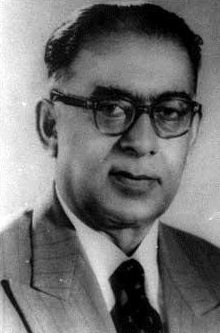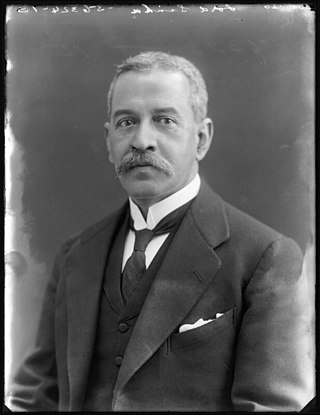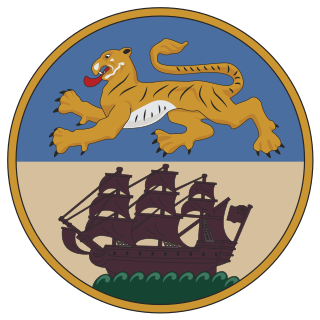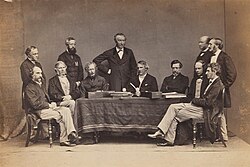
The Governor-General of India was the representative of the monarch of the United Kingdom in their capacity as the Emperor/Empress of India and after Indian independence in 1947, the representative of the Monarch of India. The office was created in 1773, with the title of Governor-General of the Presidency of Fort William. The officer had direct control only over his presidency but supervised other East India Company officials in India. Complete authority over all of British territory in the Indian subcontinent was granted in 1833, and the official came to be known as the "Governor-General of India".

Sir Tej Bahadur Sapru was an Indian freedom fighter, lawyer, and politician. He was a key figure in India's struggle for independence, helping draft the Indian Constitution. He was the leader of the Liberal party in British-ruled India.

Sir Malik Feroz Khan Noon, best known as Feroze Khan, was a Pakistani politician who served as the seventh prime minister of Pakistan from 16 December 1957, until being removed when the President Iskandar Ali Mirza imposed martial law, though he himself got ousted in the 1958 Pakistani military coup.

Satyendra Prasanna Sinha, 1st Baron Sinha, KCSI, PC, KC, was a prominent British Indian lawyer and statesman. He was the first Governor of Bihar and Orissa, first Indian Advocate-General of Bengal, first Indian to become a member of the Viceroy's Executive Council and the first Indian to become a member of the British ministry. He is sometimes also referred as Satyendra Prasanno Sinha or Satyendra Prasad Sinha.
The three Round Table Conferences of 1930–1932 were a series of peace conferences organized by the British Government and Indian political personalities to discuss constitutional reforms in India. These started in November 1930 and ended in December 1932. They were conducted as per the recommendation of Muhammad Ali Jinnah to Viceroy Lord Irwin and Prime Minister Ramsay MacDonald, and by the report submitted by the Simon Commission in May 1930. Demands for Swaraj or self-rule in India had been growing increasingly strong. B. R. Ambedkar, Jinnah, Sir Tej Bahadur Sapru, V. S. Srinivasa Sastri, Sir Muhammad Zafrulla Khan, K. T. Paul and Mirabehn were key participants from India. By the 1930s, many British politicians believed that India needed to move towards dominion status. However, there were significant disagreements between the Indian and the British political parties that the Conferences would not resolve. The key topic was about constitution and India which was mainly discussed in that conference. There were three Round Table Conferences from 1930 to 1932.

The Indian Councils Act 1909, commonly known as the Morley–Minto or Minto–Morley Reforms, was an act of the Parliament of the United Kingdom that brought about a limited increase in the involvement of Indians in the governance of British India. Named after Viceroy Lord Minto and Secretary of State John Morley, the act introduced elections to legislative councils and admitted Indians to councils of the Secretary of State for India, the viceroy, and to the executive councils of Bombay and Madras states. Muslims were granted separate electorates according to the demands of the Muslim League.

The Government of India Act 1919 was an Act of the Parliament of the United Kingdom. It was passed to expand participation of Indians in the government of India. The Act embodied the reforms recommended in the report of the Secretary of State for India, Edwin Montagu, and the Viceroy, Chelmsford. The Act covered ten years, from 1919 to 1929. This Act began the genesis of responsible government in India. It was set to be reviewed by the Simon Commission in 10 years.
The Council of India was an advisory body to the Secretary of State for India, established in 1858 by the Government of India Act 1858. It was based in London and initially consisted of 15 members. The Council of India was dissolved in 1935 by the Government of India Act 1935. It is different from the Viceroy's Executive Council based in India, which was the advisory body and cabinet of the Governor-General of India/Viceroy, which was originally established in 1773 as the Council of Four.

Nalini Ranjan Sarkar was an Indian businessman, industrialist, economist, and public leader. He was greatly involved in the political and economic regeneration of Bengal. Sarkar was Finance Minister of West Bengal in 1948. The Sarkar Committee Report was instrumental in the subsequent establishment of the four Indian Institutes of Technology (IITs) by the Government of India.

Paramasivan Subbarayan was an Indian politician, freedom fighter and diplomat and was the First Minister of Madras Presidency, India's ambassador to Indonesia and Union Minister of Transport and Communications in Jawaharlal Nehru's government. He was the father of General P. P. Kumaramangalam, who served as India's Chief of Army staff, and of politician Mohan Kumaramangalam. He was also the grandfather of INC and BJP politician and Union Minister Rangarajan Kumaramangalam.

The Imperial Legislative Council (ILC) was the legislature of British India from 1861 to 1947. It was established under the Charter Act of 1853 by providing for the addition of 6 additional members to the Governor General Council for legislative purposes. Thus, the act separated the legislative and executive functions of the council and it was this body within the Governor General's Council which came to known as the Indian/Central Legislative Council. In 1861 it was renamed as Imperial Legislative Council and the strength was increased.
Sir Syed Sultan Ahmed, KCSI was an Indian barrister and politician who had a highly successful practice as a barrister, having victories over Motilal Nehru, Tej Bahadur Sapru and Sarat Chandra Bose. He was related to Sir Ali Imam and Syed Hasan Imam, who were also from Bihar.

Lieutenant Colonel Saeed ul-Mulk Nawab Sir Muhammad Ahmad Said Khan, Nawab of Chhatari also generally referred to as Nawab of Chhatari was Governor of the United Provinces, Chief Minister of United Provinces, President of the Executive Council of the Nizam of Hyderabad and Chief Scout of India.

The Central Legislative Assembly was the lower house of the Imperial Legislative Council, the legislature of British India. It was created by the Government of India Act 1919, implementing the Montagu–Chelmsford Reforms. It was also sometimes called the Indian Legislative Assembly and the Imperial Legislative Assembly. The Council of State was the upper house of the legislature for India.

Justice Syed Mahmood was Puisne Judge of the High Court, in the North-Western Provinces of British India from 1887 to 1893, after having served in the High Court in a temporary capacity as officiating judge on four previous periods since 1882.

The Council of State was the upper house of the legislature for British India created by the Government of India Act 1919 from the old Imperial Legislative Council, implementing the Montagu–Chelmsford Reforms. The Central Legislative Assembly was the lower house.

Sir Muhammad Azizul Haque, KCSI, CIE, also known as Muhammad Azizul Huq or Mohammad Azizul Huque, was a Bengali lawyer, writer and public servant. He studied at Presidency College and University Law College in Calcutta. He worked to better the condition of Muslim people, primarily in the rural farmlands. This led him to work with Sher-e-Bangla A.K. Fazlul Haque, Sir Abdulla Suhrawardy, Sir Salimullah and Muhammad Ali Jinnah. He remained friends with many throughout his life.

The Legislatures of British India included legislative bodies in the presidencies and provinces of British India, the Imperial Legislative Council, the Chamber of Princes and the Central Legislative Assembly. The legislatures were created under Acts of Parliament of the United Kingdom. Initially serving as small advisory councils, the legislatures evolved into partially elected bodies, but were never elected through suffrage. Provincial legislatures saw boycotts during the period of dyarchy between 1919 and 1935. After reforms and elections in 1937, the largest parties in provincial legislatures formed governments headed by a prime minister. A few British Indian subjects were elected to the Parliament of the United Kingdom, which had superior powers than colonial legislatures. British Indian legislatures did not include Burma's legislative assembly after 1937, the State Council of Ceylon nor the legislative bodies of princely states.

The Bengal Legislative Assembly was the largest legislature in British India, serving as the lower chamber of the legislature of Bengal. It was established under the Government of India Act 1935. The assembly played an important role in the final decade of undivided Bengal. The Leader of the House was the Prime Minister of Bengal. The assembly's lifespan covered the anti-feudal movement of the Krishak Praja Party, the period of World War II, the Lahore Resolution, the Quit India movement, suggestions for a United Bengal and the partition of Bengal and partition of British India.













